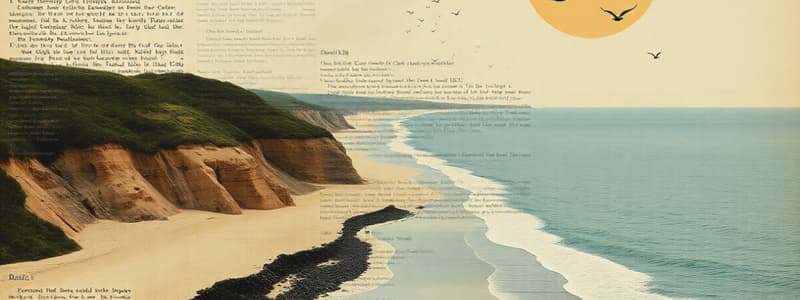Podcast
Questions and Answers
What is the primary difference between hard stabilization and soft stabilization techniques regarding coastal erosion?
What is the primary difference between hard stabilization and soft stabilization techniques regarding coastal erosion?
- Hard stabilization is a temporary solution, while soft stabilization offers permanent protection.
- Hard stabilization focuses on relocating structures, while soft stabilization involves building barriers.
- Hard stabilization uses natural materials like sand and vegetation, while soft stabilization uses man-made structures.
- Hard stabilization involves constructing barriers, while soft stabilization enhances natural processes. (correct)
Which of the following is a potential negative impact of using hard stabilization methods on coastlines?
Which of the following is a potential negative impact of using hard stabilization methods on coastlines?
- Reducing the long-term costs associated with beach maintenance.
- Improving the natural ecosystem by creating new habitats.
- Enhancing the aesthetic beauty of the beach for tourists.
- Interfering with natural ecosystems and threatening native species' habitats. (correct)
Why is beach nourishment considered a temporary solution for coastal erosion?
Why is beach nourishment considered a temporary solution for coastal erosion?
- The newly added sand is resistant to erosion from wind and waves.
- The same forces that caused the initial erosion continue to act on the replenished beach. (correct)
- It creates a permanent barrier against storm waves.
- It involves relocating structures inland, providing a lasting solution.
What is a significant environmental disadvantage of beach nourishment, as demonstrated by the example of Waikiki Beach?
What is a significant environmental disadvantage of beach nourishment, as demonstrated by the example of Waikiki Beach?
In what situation is relocation considered as a coastal erosion management strategy?
In what situation is relocation considered as a coastal erosion management strategy?
What was the primary reason for relocating the Cape Hatteras lighthouse?
What was the primary reason for relocating the Cape Hatteras lighthouse?
How does planting vegetation near the shoreline contribute to soft stabilization?
How does planting vegetation near the shoreline contribute to soft stabilization?
Which of the following best explains why hard stabilization methods might negatively affect the natural environment of a beach?
Which of the following best explains why hard stabilization methods might negatively affect the natural environment of a beach?
What is the main operational difference between groins and breakwaters?
What is the main operational difference between groins and breakwaters?
Which of the following soft stabilization techniques provides added protection from storm waves and improves beach quality for visitors?
Which of the following soft stabilization techniques provides added protection from storm waves and improves beach quality for visitors?
Flashcards
Hard Stabilization
Hard Stabilization
Using man-made structures like groins, breakwaters, and seawalls to control erosion.
Soft Stabilization
Soft Stabilization
Adding vegetation or sand to stabilize the shoreline, without constructed barriers.
Beach Nourishment
Beach Nourishment
Replenishing sand and sediment lost to erosion to widen beaches.
Relocation (Coastal)
Relocation (Coastal)
Signup and view all the flashcards
Barrier Island
Barrier Island
Signup and view all the flashcards
Study Notes
- Shorelines are dynamic environments constantly changing due to wind, waves, and currents.
- These natural forces cause erosion of shoreline structures and transport of sand along the coast.
Hard Stabilization
- Involves man-made structures designed to control erosion.
- Groins are built perpendicular to the shore to trap sand and maintain beaches.
- Breakwaters and seawalls run parallel to the beach to shield the coast from wave impact.
- While effective, these structures can be aesthetically unappealing and disrupt natural ecosystems, impacting habitats and nesting sites.
Soft Stabilization
- Involves using vegetation or sand to stabilize shorelines.
- Planting vegetation helps anchor sand and sediment, reducing erosion from wind and waves.
- Soft stabilization preserves the beach's natural appearance and habitats by using organic materials.
Beach Nourishment
- Replenishes sand and sediment lost to erosion.
- Involves transporting large amounts of sand from elsewhere to restore beach quality.
- Benefits include enhanced recreational use and increased protection from storm waves.
- High costs associated with sand transportation are a significant disadvantage.
- The introduced sand is still vulnerable to the forces that initially caused the erosion, requiring ongoing replenishment.
- Non-native sand can negatively impact local marine life.
- Example: The replacement of coarse, native sand with softer, muddier sand at Waikiki Beach led to cloudy water and the death of offshore coral reefs.
Relocation
- Involves moving structures away from the eroding shoreline.
- Considered when stabilization efforts are too expensive or challenging.
- Example: The Cape Hatteras lighthouse in North Carolina was relocated inland in 1999 due to persistent erosion, despite previous stabilization attempts.
Studying That Suits You
Use AI to generate personalized quizzes and flashcards to suit your learning preferences.




